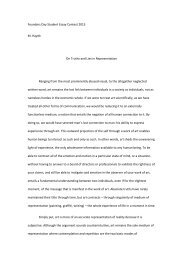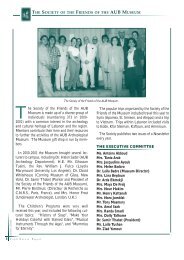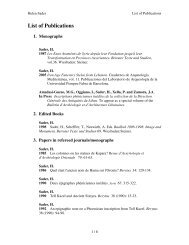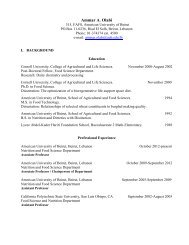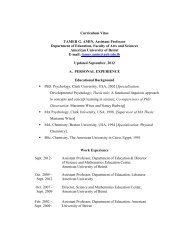The IX t h Makassed Medical Congress - American University of Beirut
The IX t h Makassed Medical Congress - American University of Beirut
The IX t h Makassed Medical Congress - American University of Beirut
You also want an ePaper? Increase the reach of your titles
YUMPU automatically turns print PDFs into web optimized ePapers that Google loves.
T h e I X t h M a k a s e d M e d i c a l C o n g r e s s<br />
detect the presence and persistence <strong>of</strong> edge dissections, assess vascular responses such as<br />
remodeling, study edge effects, compare overlapping with nonoverlapping segments, and look<br />
for causes <strong>of</strong> restenosis and thrombosis.<br />
In conclusion, IVUS provides unique insights during DES implantation, allows DES optimization<br />
and should always be used during the management <strong>of</strong> DES failures: in-stent restenosis and DES<br />
thrombosis.<br />
MANAGEMENT OF HAEMOPERICARDIUM DURING PERCUTANEOUS MITRAL<br />
COMMISSUROTOMY<br />
Georges Ghanem MD, FESC, FACC<br />
Background: Haemopericardium is a severe complication <strong>of</strong> percutaneous mitral commissurotomy<br />
(PMC) due to transseptal catheterization. <strong>The</strong>re are no particular recommendations in the literature<br />
on the management <strong>of</strong> this complication during PMC. Our objective is to review and analyze the<br />
cases <strong>of</strong> haemopericardium in a series <strong>of</strong> 245 patients, and provide certain recommendations for<br />
its management during PMC.<br />
Patients and Methods: Between January 1993 and December 2008, 60 males and 218 females<br />
with severe mitral stenosis were enrolled. <strong>The</strong> mean age was 44 years old. 89% were class III NYHA.<br />
<strong>The</strong> mean echo score was 8.5.<br />
Results and Haemopericardium Management: <strong>The</strong> Inoue technique was used for all the<br />
procedures. Overall, the procedure was performed successfully in 98%. Death occurred in 0, 4%,<br />
severe mitral regurgitation occurred in 0, 8% and haemopericardium in 2, 1% (all female patients).<br />
<strong>The</strong> management <strong>of</strong> haemopericardium in these patients was as follows: <strong>The</strong> 1st patient, a 45<br />
year-old female, was sent immediately to surgery for open pericardiocentesis and mitral valve<br />
replacement. <strong>The</strong> 2nd patient, a 28 year-old female, had a pericardiocentesis in the cath lab,<br />
and then surgery was performed on an elective basis. <strong>The</strong> 3rd patient, a 50 year-old female, had a<br />
pericardiocentesis in the cath lab, and then 24 hours later a PMC was done with successful results.<br />
<strong>The</strong> 4th patient, a 35 year-old 7-months pregnant female, was managed as follows: Heparin was<br />
immediately reversed with Protamin. <strong>The</strong>n, a pericardiocentesis was performed after 6F sheath<br />
installation into the pericardium under echo-guidance.<br />
We Reinjected the drained blood from the pericardium into systemic circulation via the femoral<br />
vein.<br />
Due to pregnancy, the patient was at high risk for surgery, therefore, the procedure was<br />
continued with one balloon inflation immediately at the appropriate diameter corresponding to<br />
the patient’s height (height/10 + 10) with successful result. <strong>The</strong> follow-up and the delivery were<br />
totally normal.<br />
<strong>The</strong> 5th and 6th patients, 53 and 64 year-old females, were managed exactly the same way<br />
as the 4th patient with successful results. To note that the 5 th patient was operated for open<br />
pericardiocentesis on the cath lab table for a large posterior right atrium tear, immediately after<br />
a successful dilatation <strong>of</strong> the valve and balloon retrieval.<br />
Conclusion: Although haemopericardium is a complication <strong>of</strong> PMC, our clinical experience demonstrates<br />
that it could be successfully managed in the cath lab through continuing PMC after pericardiocentesis and<br />
heparin reversing.<br />
Such management regime could be particularly beneficial for patients at high risk for surgery (ex. pregnancy).<br />
94






